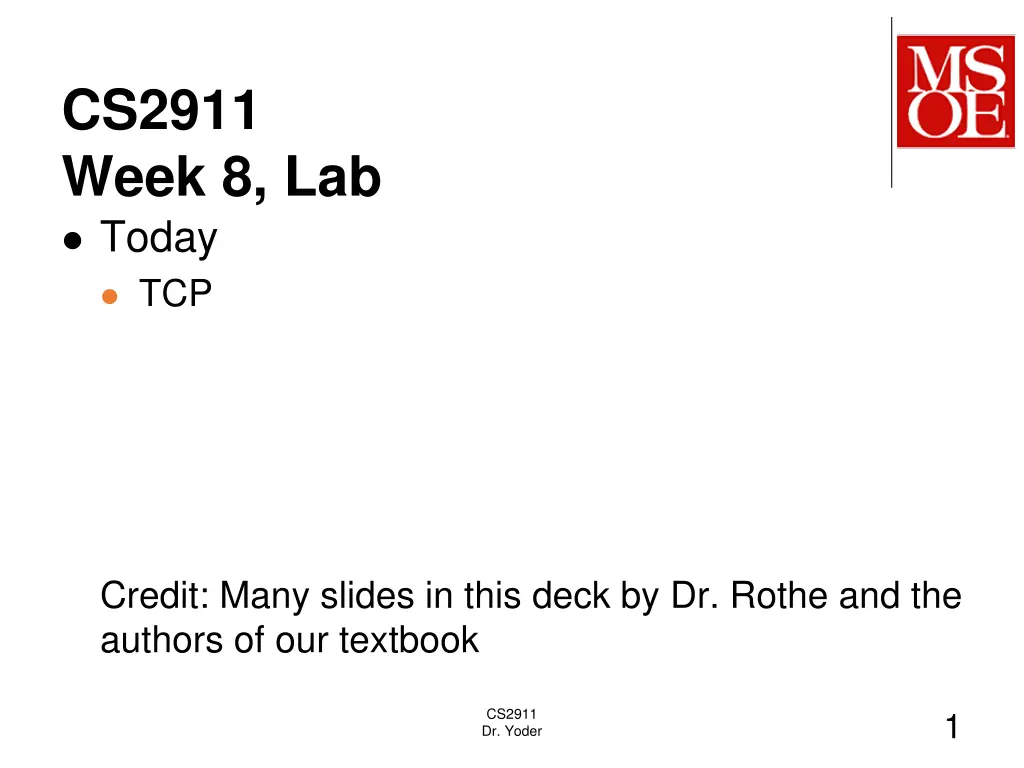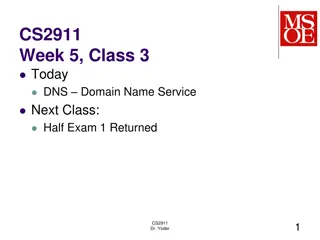
Understanding TCP Header and Reliable Transport
Dive into the world of TCP protocol with this comprehensive guide covering TCP header layout, field descriptions, 3-way handshake behavior, reliability strategies, and data transfer specifics. Explore potential issues like packet loss and corruption, while learning about error detection and retransmission techniques. Gain insights into the formatting of field values and the significance of sequences and acknowledgments in TCP communication.
Download Presentation

Please find below an Image/Link to download the presentation.
The content on the website is provided AS IS for your information and personal use only. It may not be sold, licensed, or shared on other websites without obtaining consent from the author. If you encounter any issues during the download, it is possible that the publisher has removed the file from their server.
You are allowed to download the files provided on this website for personal or commercial use, subject to the condition that they are used lawfully. All files are the property of their respective owners.
The content on the website is provided AS IS for your information and personal use only. It may not be sold, licensed, or shared on other websites without obtaining consent from the author.
E N D
Presentation Transcript
CS2911 Week 8, Lab Today TCP Credit: Many slides in this deck by Dr. Rothe and the authors of our textbook CS2911 Dr. Yoder 1
Outcomes Be familiar with the layout of the TCP header Describe the purpose of the following TCP header fields: Source Port, Dest Port, Sequence number, Acknowledgement number Receive window Checksum Calculate sequence and acknowledgement numbers Describe the behavior of the 3-way handshake 2
TCP Header format http://ps- 2.kev009.com/wisclibrary/aix51/usr/share/ man/info/en_US/a_doc_lib/aixbman/comm admn/tcp_protocols.htm SE-2811 Dr.Yoder 4
Formatting of Field Values Like UDP, all fields are stored in raw binary in a big-endian order (most significant byte first) SE-2811 Dr.Yoder 5
Exercise: Looking at a TCP header (See exercise) CS2911 Dr. Yoder 6
How things can go wrong Corrupted packets Lost packets Reordered packets Malicious packets
Strategies for Reliability Error Detection Receiver Feedback Retransmission
Strategies for Reliability Error Detection Checksum Receiver Feedback ACK acknowledgment NAK negative acknowledgment (Missing ACK) Retransmission Sender resends the segment requested in the NAK or which had the ACK missing
Stop and Wait RTT Round Trip Time
TCP Data Transfer Specifics Data transferred as a stream of octets (bytes) Data is transferred in segments, but acknowledged at the octet level Full duplex data can be transferred in either direction, or both Both endpoints of connection must maintain buffers/windows for both sending and receiving
Exercise: TCP sequence & acknowlegement numbers TCP sequence numbers actually start at a random number To establish the number, the sender sends the random first sequence number. The receiver replies with the sequence number + 1 After this, the current sequence number is always first number + 1 + total number of bytes sent/received
Starting a TCP sequence Client Server SYN, SEQ = 368 ACK, ACK = 369 SEQ = 369, 10 bytes data ACK, ACK = 379 SEQ = 379, 10 bytes data ACK = 389
Server also can send data Client Server SYN, SEQ = 824 ACK, ACK = 825 SEQ = 825, 30 bytes data ACK, ACK = 855 SEQ = 855, 20 bytes data
All together now Client Server SYN, SEQ = 368 ACK, ACK = 369 Three-way Handshake SYN, SEQ = 824 SEQ = 369, 10 bytes data ACK, ACK = 825 SEQ = 825, 30 bytes data ACK, ACK = 379 SEQ = 379, 10 bytes data ACK, ACK = 855 SEQ = 855, 20 bytes data ACK = 389
Exercise Fill in the blanks of the sample TCP message in the exercise.
Closing a TCP connection Client Server FIN SEQ = 835 ACK = 836 FIN SEQ = 529 ACK = 530
Closing a TCP connection Client FIN, SEQ = 835 ACK, ACK = 529 Server SEQ = 529 ACK, ACK = 836 FIN, SEQ = 529 ACK, ACK = 836 SEQ = 836 ACK, ACK = 530
Retransmission after timeout Client SYN, SEQ = 368 ACK, ACK = 369 SEQ = 369, 10 bytes data SEQ = 369, 10 bytes data ACK, ACK = 379
Exercise See the exercise on viewing both ends of an HTTP capture CS2911 Dr. Yoder 22
Acknowledgements are cumulative Acknowledgement of any octet implies receipt of all previous octets Simple Lost acknowledgements will not necessarily result in retransmission
Acknowledgements are cumulative Acknowledgement of any octet implies receipt of all previous octets
Acknowledgements are cumulative Acknowledgement of any octet implies receipt of all previous octets What if timeout ended here? Think (30 s) Pair (30 s) Shair
Senders Window 1, 2 have been sent and acknowledged 3 6 sent but not acknowledged 7 9 have not been sent but can be without delay 10 and higher will not be sent until window moves
Window Advertisement Window size can vary over time Receiver sends a windows size with acknowledgement that indicates how many octets it is willing to accept Allows flow control An advertisement of 0 will halt transfer
Sliding Window - Pipelined Requires buffering on each end Remaining space on receiver in last acknowledgement
Sliding Window supports Flow Control Won't over-fill receiver's buffer Waits for receiving application to be ready This is one reason to call recv even before we have gotten the whole message
Flow vs. Congestion Control Flow control is a function of the receiver and its ability to accept data Congestion control is a function of the network and its ability to carry messages Congestion control avoids sending more data than the network can handle, resulting in collapse of the network
New Variable - cwnd Two windows Un-acknowledged bytes cwnd congestion window rwnd receive (flow control) window
cwnd We can send up to cwnd bytes per RTT period Average transmission rate is roughly cwnd/RTT bytes/sec By manipulating cwnd, transmission rate can be controlled
Congestion Detection If segments lost, maybe we are sending too many Adjust cwnd Decrease when a segment is lost Increase when ACKs are received Continue to increase until a segment is lost, then backoff
TCP Slow Start Start with a small cwnd (one MSS)
Challenge: How to avoid accidental message? What if a TCP message from a previous connection gets stuck in a router for a while, but then eventually gets delivered later? How to avoid it being mistaken for the newer message?
A very brief history of the internet 1957 Sputnik launched, ARPA formed 1962 ARPA forms IPTO to create ARPAnet 1969 First packet switched network at UCLA 1971 First emails with @ signs 1983 TCP/IP first deployed 1986 NSFNET created (& many others) 1989 HTTP starts with just GET 1991 NSFNET allows commercial activities. e-Bay, Google, Amazon 2000's Facebook, Twitter, Youtube, Source: Kurose & Ross, 6th, Ed, Section 1.7 and http://www.calvin.edu/academic/rit/webBook/chapter3/Introduction/arpanet.htm http://www.livinginternet.com/e/ei.htm Wiki: HTTP
Acknowledgement The content of this video is based in part on lecture slides from a very good textbook, and used with the author s permission: Computer Networking: A Top-Down Approach, 7th edition, by Jim Kurose and Keith Ross Publisher: Pearson, 2017
Timeout and Retransmission What do we use for a timeout? LAN round-trip time for ACK might be ms Internet 100x Varies over time
Adaptive Retransmission Round-trip time (RTT) is monitored for each transmission/ACK 0 < 1 Recommended value of = 0.128 [RFC 6298] Recommended is 0.25

